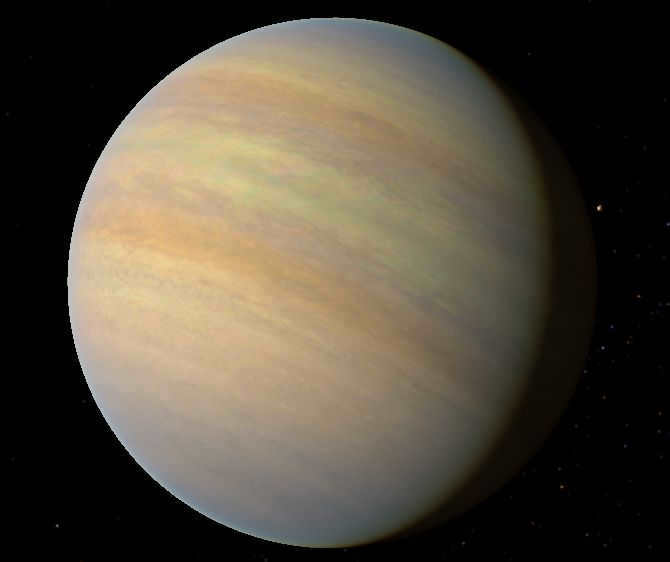
The primary distinction among giant planets is their lack of a conventional solid surface. They exist as enormous spheres, primarily consisting of gas. As a result, they are often referred to as gas giants. Consequently, humans will never be able to stroll upon the surfaces of Jupiter or Saturn, or even on the lunar terrain.
However, giants are not solely composed of gas. The reason being that as the atmosphere approaches the planet’s core, it becomes increasingly denser and consequently transitions from a gaseous state to a liquid one. Nevertheless, gas giants do not possess a distinct boundary between the ocean and the atmosphere (as seen on Earth). By the way, this ocean is not composed of water but primarily consists of liquid hydrogen.
At even greater depths, the pressure becomes so extreme that the liquid hydrogen transforms into a metallic state. Below this layer of metallic hydrogen lies the core of the planet, which is composed of highly compressed rock.
The vast size of gas giants is another notable characteristic. The smallest gas giant in our Solar System is Neptune, with an average radius of 24,622 km. In comparison, Earth, the largest terrestrial planet, has a radius of only 6,371 kilometers. The difference in mass is even more significant, with Neptune being 17 times more massive than Earth. However, the largest gas giant is Jupiter, with an estimated radius of 69,911 km and a mass nearly 318 times that of Earth.
The solar system exhibits a distinctive feature in which the orbits of Earth-type planets are significantly closer to the central star compared to the orbits of giant planets. For instance, Mars, the farthest Earth-type planet from the star, never exceeds a distance of 250 million kilometers from the Sun. In contrast, the closest giant planet to the star, Jupiter, is always at a minimum distance of 740 million kilometers away. Typically, the solar system can be divided into two distinct regions: the inner region, encompassing the orbits of Earth-type planets, and the outer region, housing the orbits of giant planets.
Gas giants have a unique feature of having much shorter days compared to Earth. For instance, Jupiter completes one rotation on its axis in approximately 10 hours, while Neptune takes about 16 hours. However, due to their vast distance from the Sun, the duration of a year on these planets is exceptionally long. On Neptune, a year lasts for 164 Earth years. As a result, the year on gas giants is comprised of thousands, and in some cases, even tens of thousands of days.
In addition to having satellites, giants also possess rings. The discovery of these rings was first made in 1656 near Saturn using a conventional telescope with 50x magnification. The other giant rings were not found until the latter half of the 20th century, primarily due to the proximity of space probes to these planets. Giant rings consist of numerous small particles of dust and gas that are always positioned directly above the equator of the planet.
The dominant chemical composition of the giant planets is hydrogen. Its proportion can range from 80% (Neptune) to 96% (Saturn). The second most prevalent element is helium. All other substances account for no more than 2-3% of the planet’s mass.
Which of the Earth-group planets is larger than the others in size?
The biggest planet in the Earth group, Earth, is more than 14 times smaller in mass than the lightest gas planet, Uranus, yet it is about 400 times heavier than the largest known object in the Kuiper belt.
How are giant planets different from Earth-like planets?
What are the differences between giant planets and Earth-like planets? The main distinctions include size, density, atmosphere, chemical composition, rotational speed, surface characteristics, and presence of moons. …Density higher than water. Sparse atmosphere.
Which planet has the highest compression at its poles?
Jupiter, similar to the Sun, does not have a solid rotation, but rather rotates as a gaseous body. The speed of rotation differs at various latitudes. Due to its fast rotation, Jupiter experiences significant compression at its poles. In terms of mass, Jupiter is 318 times heavier than Earth.
What are the primary features of colossal planets?
In contrast to the solid planets in the Earth group, all colossal planets have significantly larger dimensions and masses (leading to higher pressures in their cores), lower average densities (approximately equal to the average density of the sun, 1.4 g/cm³), strong atmospheres, rapid rotation, and ring systems…
Giant planets possess significant masses. It is a well-known fact that the greater an object’s mass, the stronger its gravitational force. In other words, the more massive a planet is, the greater its ability to attract and retain an atmosphere. Jupiter, Uranus, and Neptune boast the most expansive atmospheres.
What is the number of planets in our solar system that have rings?
Rings can be observed surrounding all of the gas giants in our solar system, namely Saturn, Jupiter, Uranus, and Neptune. Additionally, rings have been detected around the asteroids Chariklo and Chiron, the dwarf planet Haumea, and there is a hypothetical possibility of rings encircling Saturn’s moon Rhea.
What is the reason behind the naming of the giant planets?
The giant planets, namely Jupiter, Saturn, Uranus, and Neptune, earned their name due to their immense size, second only to the Sun, in the solar system. These celestial bodies are situated outside the main asteroid belt and are often referred to as “outer planets.”
What causes the distinctive flattened shape of the giant planets?
What is the explanation for the flattened shape of the giant planets as opposed to the Earth-group planets? The giant planets have a significantly lower density compared to the Earth-group planets, making them gas planets. As a result of their low density and high angular velocity, these planets experience compression at their poles, leading to their flattened appearance.
Which planet is the smallest in the Earth group?
Mercury, the first planet in the solar system, is the smallest planet in the Earth group, which also includes Venus and Mars, in addition to Earth.
What is the common feature among all the planets in the Earth group?
1) Both groups of planets have a star that they orbit around. 2) Both groups of planets have satellites, although not all of them. 3) All planets have a similar structure with a central core, only the chemical composition of the outer layers differs.
We have prepared a number of reports on the topic of “Giant Planets”. The information in this article can be used to help with school essays on astronomy and the world around us.
Report 1
The giant planets, including Jupiter, Saturn, Uranus, and Neptune, are the largest objects in our Solar System after the Sun. They are known as the “outer” planets because they are located beyond the Main Asteroid Belt. Jupiter and Saturn are classified as gas giants, composed primarily of hydrogen and helium in a solid state. Uranus and Neptune, on the other hand, are classified as ice giants due to the presence of high-temperature ice in their composition instead of metallic hydrogen. While the giant planets are significantly larger than Earth, they are still relatively small compared to the Sun:
Computer simulations have revealed that the presence of massive planets is crucial in safeguarding the inner planets of the Earth group from potential collisions with asteroids and comets. In the absence of these celestial bodies within our solar system, the likelihood of our Earth being struck by asteroids and comets would increase exponentially, by hundreds of times! Consequently, one may wonder, how exactly do these colossal planets shield us from these unwelcome cosmic visitors?
Jupiter, the largest of the giant planets, holds the first position in the solar system. It boasts the title of being the largest planet in our system. Some refer to Jupiter as a star that failed to ignite its own nuclear reactions due to its insufficient mass. However, Jupiter’s mass is gradually increasing as it absorbs interplanetary matter such as comets, meteorites, dust, and solar wind. According to one theory of solar system development, if this trend continues, Jupiter has the potential to evolve into a star or a brown dwarf, resulting in a double star system for our solar system. Interestingly, double star systems are quite common in the vast cosmos surrounding us, whereas single stars, like our sun, are comparatively smaller.
Calculations indicate that Jupiter is currently emitting a greater amount of energy than it receives from the Sun. If this is indeed the case, it suggests that nuclear reactions are already occurring within Jupiter, as there would be no other source for this energy. This phenomenon is indicative of Jupiter transitioning into a star rather than remaining solely a planet…
Next in line is the well-known celestial body of our solar system – the immense planet Saturn, renowned primarily for its magnificent rings. Composed of ice particles ranging in size from minuscule specks of dust to sizable chunks of ice, Saturn’s rings span an impressive outer diameter of 282,000 kilometers, while maintaining a thickness of only about one kilometer. Consequently, when observed from a side perspective, Saturn’s rings remain hidden from view. However, Saturn is also accompanied by a host of satellites. To date, approximately 62 satellites have been identified orbiting Saturn. The largest among them is Titan, which actually surpasses the planet Mercury in size! Nevertheless, Titan is predominantly composed of frozen gas, rendering it considerably lighter than Mercury. If Titan were to occupy Mercury’s orbit, the icy gas would rapidly evaporate, causing a significant reduction in Titan’s overall dimensions.
Enceladus, another fascinating moon of Saturn, has captured the attention of scientists due to the presence of a subterranean ocean of liquid water beneath its icy shell. This discovery raises the possibility of life existing on Enceladus, as the temperatures there are conducive to sustaining life. Additionally, the recent identification of powerful water geysers shooting hundreds of kilometers into space further emphasizes the potential for this moon to harbor life.
Interestingly, all the planets in our solar system are named after Roman gods, with the exception of Uranus, which is named after a Greek god. The acceleration of free fall at the equator of Uranus measures 0.886 g, meaning that the force of gravity on this massive planet is actually lower than that on Earth! This is due to the planet’s incredibly low density, which sets it apart from the rest of the giants in our solar system. While spacecraft have flown by Uranus and captured images, no comprehensive studies have been conducted yet. However, NASA has plans to send a research station to Uranus in the 2020s, and the European Space Agency also has its own plans in the works.
On the other hand, Neptune, which is now the farthest planet in our solar system after Pluto was reclassified as a “dwarf planet,” is similar to the other gas giants in terms of size and weight – it’s significantly larger and heavier than Earth.
Neptune, similar to Uranus, is a massive planet made up of ice. Due to its great distance from the Sun, Neptune was actually the first planet to be discovered through mathematical calculations instead of direct observation. Astronomers at the Berlin Observatory visually spotted the planet through a telescope on September 23, 1846, using the calculations made by the French astronomer Leverrier.
Interestingly, drawings from as early as 1612 show that Galileo Galilei had actually observed Neptune before its official discovery. However, he mistook it for a fixed star and did not recognize it as a planet. As a result, Galileo is not credited with the discovery of Neptune. Despite its large size and mass, Neptune is actually less dense than Earth, with a density about 3.5 times smaller. This means that the gravity on Neptune is only 1.14 times that of Earth, which is similar to the gravity on the previous two giant planets.
Abstract 2
The planets in our solar system did not all come into existence at the same time. They formed approximately 4.6 billion years ago, emerging from the remnants of the Sun’s birth. This involved a swirling disk composed of hydrogen, helium, rock particles, iron, and ice. Through the gravitational forces at play, these particles clumped together to form four rocky planets. Further out, gas and dust coalesced to create the gas giants, which we will now explore. What sets them apart? And what unique characteristics does each planet possess?
Jupiter, the largest planet in our solar system, is a behemoth that is 1000 times more massive than Earth. It is composed mainly of hydrogen and helium, with hydrogen being a crucial source of fuel for stars. Interestingly, if Jupiter were 80 times larger, it would have the potential to transform into a star. Furthermore, Jupiter possesses an incredibly strong gravitational force. This immense pull not only attracts 63 satellites, but it also diverts a significant portion of asteroids that would otherwise be on a collision course with Earth.
While Jupiter is renowned for its size and gravitational power, Saturn, another gas giant, is notable for its magnificent rings. Although other gas giants have rings, none compare to the sheer beauty of Saturn’s rings. Unfortunately, these rings cannot be seen without the aid of telescopic equipment. In addition to its rings, Saturn is also home to an intriguing moon called Titan. Titan’s atmosphere raises the possibility of the existence of extraterrestrial life forms. Lastly, it is worth mentioning that Saturn is the lightest planet in our solar system. In fact, if you were to place Saturn in an ocean, it would not sink due to its relatively low density.
For a significant period, the location and true identity of the celestial body in question remained elusive. It was not until 1690 that John Flemsteed, a notable astronomer, stumbled upon what he believed to be a star and was in fact Uranus. However, it was not until 1781 that William Herschel, utilizing a telescope, gazed upon Uranus and initially misidentified it as a comet. Through further scrutiny of fellow astronomers’ observations, Herschel eventually deduced that Uranus was indeed a planet. Unlike its gas-dominated counterparts, Uranus boasts a higher proportion of icy matter. Furthermore, its unique characteristic of orbiting the Sun on its side sets it apart from other celestial bodies.
This particular planet, known as Neptune, was first detected by German astronomer Johann Gottfried Galle in the year 1846. A single year on Neptune spans a staggering 164 Earth years, making it a rather intriguing celestial object. It is worth noting that Neptune experiences incredibly forceful winds, with velocities reaching an astounding 2,000 kilometers per hour, akin to the swiftness of the fastest jet aircraft.
Within our Universe, there exist numerous colossal planets possessing comparable physical characteristics, commonly referred to as “giant planets”. These celestial bodies are also recognized as outer planets due to their placement beyond the confines of the asteroid belt, the celestial region residing between Jupiter and Mars. Our solar system specifically houses four giant planets, namely Jupiter, Saturn, Uranus, and Neptune.
All of these celestial bodies possess immense sizes and masses, which surpass those of other celestial entities by thousands of times. For instance, Neptune boasts a mass 17 times greater than that of Earth, while Jupiter’s mass is a staggering 318 times larger. Moreover, the giants rotate around their axes a number of times that exceeds the revolutions of other planets. It is worth mentioning that the polar regions of these giants exhibit slower rotation compared to their equatorial zones. The remarkably swift rotation of these giants leads to a significant compression, as multiple observations by scientists have confirmed.
Due to the considerable distance from the central star of our solar system, the giant planets constantly experience cold temperatures, regardless of the time of year. One interesting characteristic of these planets is their unique seasonal changes or lack thereof, depending on the tilt of the planet’s axis in relation to its orbit. The closer the tilt angle is to 90 degrees, the less pronounced the differences in seasons, and when the tilt is perpendicular, there is no change in seasons at all. In addition to this, each of the giant planets is surrounded by a multitude of satellites. Jupiter has a total of 79 satellites, Saturn has 62, Uranus has 27, and Neptune has 17. It’s also worth noting that all of these planets possess rings.
Giants possess a fascinating characteristic: they are all composed of gas. Additionally, it is observed that they have robust atmospheres that prevent the exploration of the substance beneath the gas cloud. Moreover, the outer planets exhibit a lower average density, similar to that of the Sun. In terms of chemical composition, giants differ significantly from planets with a lithosphere. All giants exhibit a powerful magnetic field, which scientists believe is a result of the rapid rotation of matter in the equatorial regions, generating electric current. This unique trait gives rise to radiation belts surrounding each giant, consisting of charged particles that disperse across millions of kilometers.
Unique Abstract 4
Gigantic planets are celestial bodies in the solar system that have acquired this name due to their immense size. They consist of four planets, namely Saturn, Jupiter, Uranus, and Neptune. These planets possess distinct characteristics that enable them to be categorized as a single group. The asteroid belt serves as a demarcation line between the regular planets and the colossal planets situated beyond it. Massive planets are primarily composed of various gases. They are bound together by their massive dimensions, swift rotation on their axes, and low density. Each of these planets boasts a considerable number of natural satellites, ranging from 14 to 72, as well as rings. The cores of Uranus and Neptune contain a significant amount of high-temperature ice. These gigantic planets play a vital role in safeguarding our planet, as well as the other three rocky planets, against potential collisions with asteroids.
Jupiter, situated beyond the asteroid belt, stands as the initial gas planet and holds the title of being the largest. Its mass continues to increase as it absorbs interplanetary matter. The composition of this celestial body is primarily made up of elements such as helium and hydrogen. Despite receiving less energy from the Sun than it radiates, Jupiter experiences nuclear reactions. This leads to the widespread belief that Jupiter has the potential to transform into a star in due time. Jupiter’s atmosphere is characterized by incredibly powerful storms. For countless centuries, observers on Earth have noted the presence of the Great Red Spot, an enormous atmospheric vortex, on Jupiter. Furthermore, Jupiter possesses a total of 79 satellites, including Ganymede, the largest satellite in the entire solar system, which is affiliated with this gas giant.
Following Jupiter is the planet Saturn, renowned for its rings made up of ice particles and varying sizes and dust. The rings have a much greater diameter than thickness, rendering them invisible when observed from the exterior. Among all the planets, Saturn has the lowest density, even lower than that of water. Additionally, Saturn boasts an impressive collection of 62 satellites. Of these satellites, Titan, belonging to Saturn, reigns as the second largest in the entire solar system, surpassing Mercury in size. Titan alone possesses a dense atmosphere, setting it apart from other satellites. Saturn completes its orbit around the Sun every 29 and a half years. From Earth, Saturn is visible to the naked eye.
Uranus, the third largest planet, possesses a distinctive characteristic in its axis of rotation, which aligns with the plane of its orbit around the Sun. As a result, Uranus experiences alternating periods where either the North Pole or the South Pole is illuminated for a duration of 42 Earth years. The planet’s atmosphere consists of a blend of gases, with notable vortices observed within it. Unlike Earth, Uranus lacks a solid surface due to its gas-to-liquid composition. The interior of Uranus is composed of ice and rocks, contributing to its unique makeup. Uranus boasts a record-breaking minimum temperature, plummeting to as low as -200°, making it colder than even Neptune, which resides at the outermost edge of the solar system. Wind speeds on Uranus reach staggering velocities surpassing 200 meters per second. Despite its larger size compared to Earth, Uranus exhibits lower gravity. Additionally, Uranus has a total of 27 moons.
Neptune, situated at the outermost reaches of our solar system, holds the distinction of being the furthest planet from the Sun. Unlike its neighboring planets, Neptune cannot be observed with the naked eye. Rather, its existence was determined not through direct visual observation via telescope, but through meticulous mathematical calculations. While smaller in size compared to Uranus, Neptune boasts a greater mass and density. This colossal planet also emits a significant amount of internal heat. Remarkably, Neptune is characterized by supersonic winds that travel in the opposite direction to the planet’s rotation. These powerful winds are fueled by the planet’s internal energy. Currently, 14 satellites have been discovered orbiting Neptune.
As someone who is deeply passionate about astronomy and devotes their spare time to the subject, I would be delighted to share my knowledge on this fascinating topic. Without further ado, let’s delve into the intricacies of the cosmos. 🙂
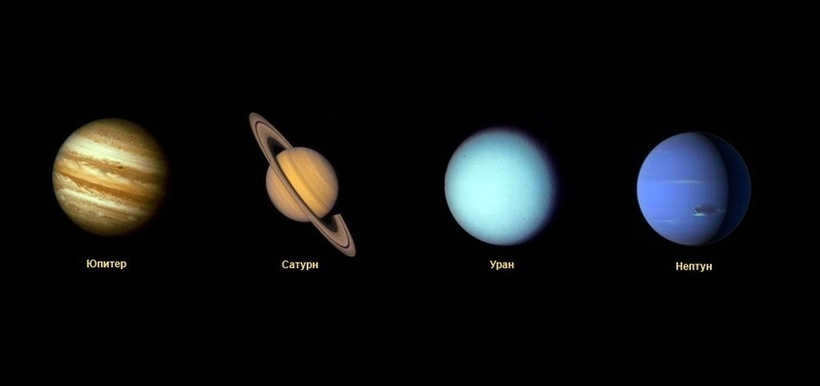
Distinctive Features of the Enormous Planets
All members of this category, as their name suggests, possess a colossal size, thereby resulting in immense masses. This assemblage encompasses Uranus, Saturn, Neptune, and Jupiter. The latter, being the most substantial representative, surpasses our planet by a whopping 1325 times in volume and 320 times in mass! They exhibit a tremendous rotational velocity, with the poles spinning significantly faster than the polar regions. Consequently, this leads to substantial compression, which is easily discernible visually. To illustrate, the Earth displays a discrepancy of 22 kilometers between the circumference of its poles and the equator, whereas Jupiter presents a staggering 4500 km difference.
Due to their composition of helium and hydrogen, these celestial bodies lack solid surfaces. Consequently, the region beneath the atmospheric upper edge remains inaccessible for visual examination, prompting scientists to rely on supplementary data to infer ongoing processes. For instance, the analysis of temperature patterns has enabled the construction of a comprehensive model for these entities, facilitating calculations of pressure and density.
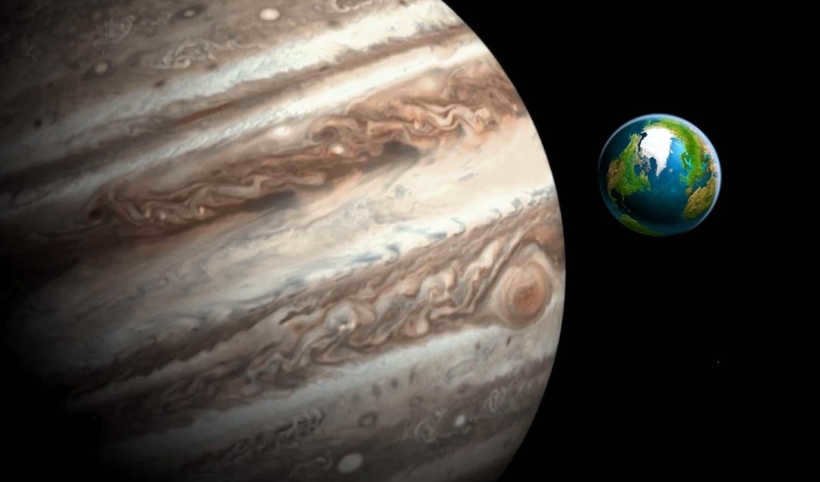
Satellites and rings
Each planet within this group possesses a multitude of satellites, such as Jupiter, which bears a striking resemblance to a miniaturized solar system. The satellites themselves exhibit a wide range of characteristics, with some displaying cratered surfaces while others boast towering mountain ranges. However, the most intriguing is Titan, a moon within the Saturn system, which has been discovered to possess an atmosphere that bears a striking resemblance to that of Earth’s. The first observation of Saturn’s rings was made by Galileo, and subsequent research has shown that all planets within this group possess such rings.
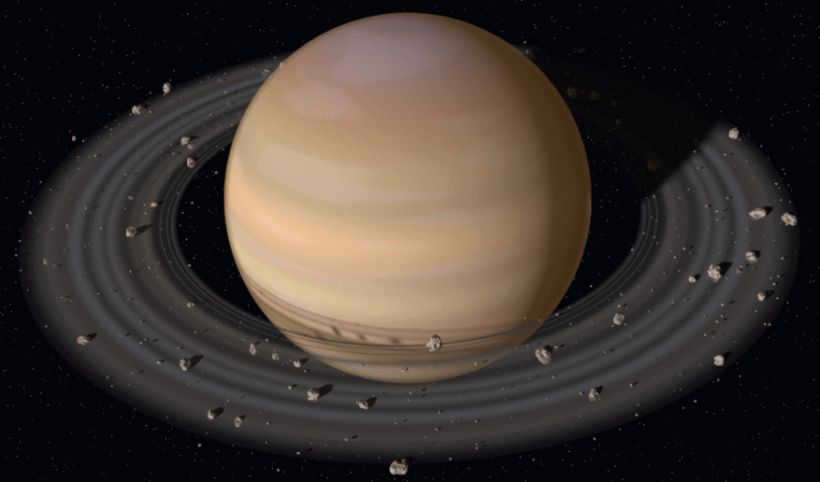
Shared Characteristics of Giant Planets
Upon closer inspection, we can conclude the following:
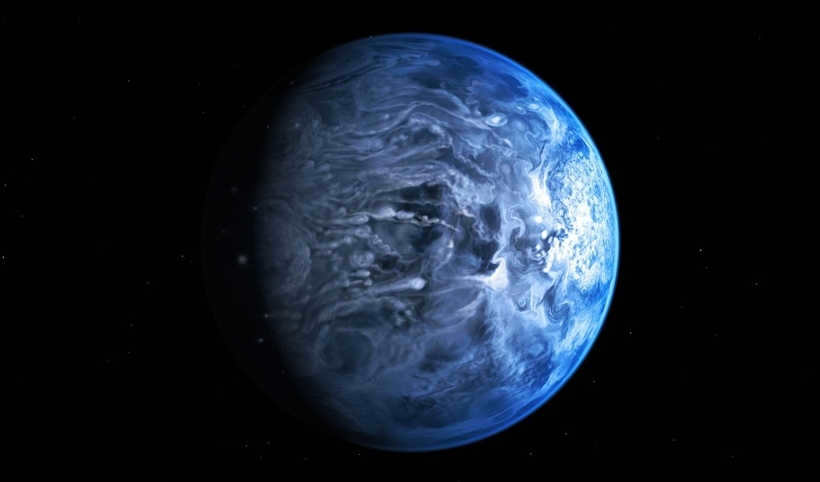
- There is no solid surface on Jupiter.
- Jupiter is an enormous planet, with hydrogen making up most of its composition.
- It has a giant mass and low density.
- Jupiter has a high rotational velocity, which results in strong compression.
- It also has ring systems.
- Furthermore, Jupiter has a large number of satellites.
I trust that my efforts have not been in vain, and that the information provided will prove beneficial to someone.
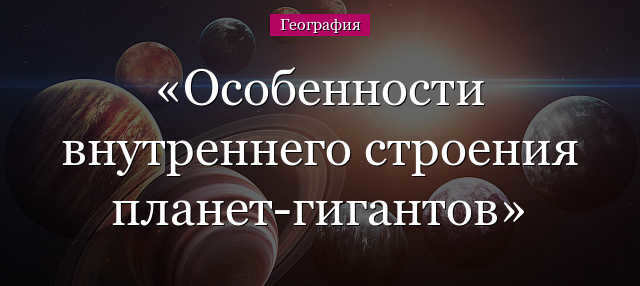
Giant planets, which do not have a solid surface, are characterized by their massive size. They often have numerous satellites orbiting around them. In our solar system, there are four giant planets: Jupiter, Saturn, Uranus, and Neptune. These celestial bodies are the largest objects in our solar system, second only to the Sun in terms of size. In this article, we will provide a concise overview of the unique characteristics of the internal structure of these massive planets.
The primary characteristic that sets the giant planets apart is their lack of a solid surface. These immense celestial bodies are primarily composed of gases, leading them to be commonly referred to as gas giants.
As one delves deeper into the atmosphere of these giant planets, the gaseous composition gives way to a denser liquid form. Unlike Earth, the gas giants lack a distinct boundary separating their oceans from the atmosphere. Additionally, the ocean within these planets is comprised of liquid hydrogen rather than water.
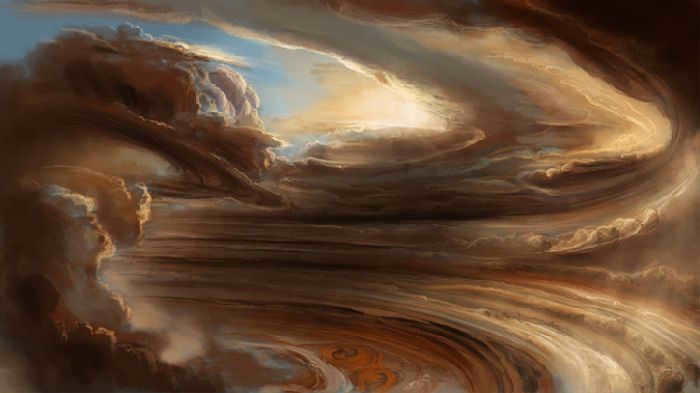
As giant planets get closer to their cores, the immense pressure causes the hydrogen within them to transform into a metallic state, a phenomenon that cannot be replicated on Earth. Below this layer of metallic hydrogen lies the planet’s core.
Remarkable magnitude
Enormous magnitude is a significant characteristic of all colossal planets. Because of their immense size, these planets are capable of hosting a substantial quantity of satellites and rings comprised of ice and rocks varying in dimension. All four colossal planets possess rings; however, Saturn boasts the most prominent ones.
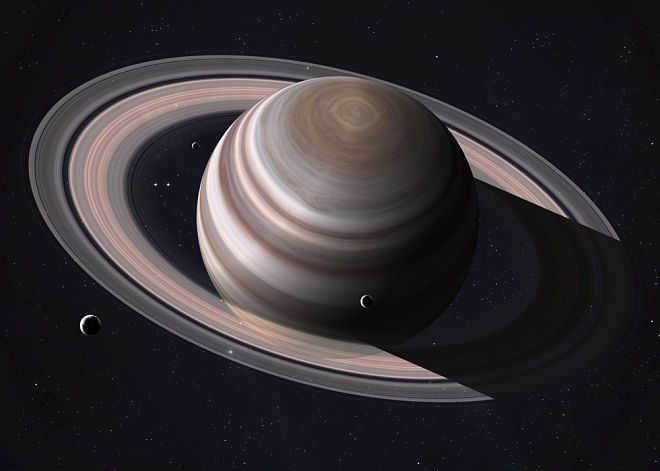
Characteristics of the atmosphere
The structure of the inner layers of giant planets, located at a considerable distance from Earth, cannot be accurately determined in terms of chemical composition. However, the composition of their atmospheres is well-documented. The atmospheres of giant planets consist primarily of hydrogen, ranging from 80% in Neptune to 96% in Saturn. Helium is the second most abundant element.
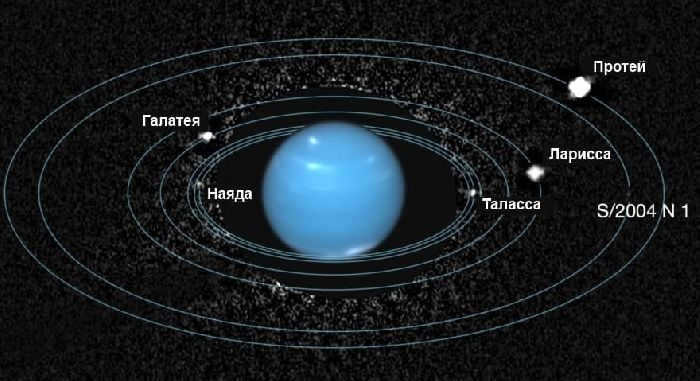
Neptune and its moons are depicted in Figure 3.
The atmospheres of the gas planets contain additional elements, but their combined amount does not surpass 2-3%. These elements include carbon, nitrogen, sulfur, and oxygen, which combine to form compounds like hydrogen sulfide, methane, water, phosphine, and ammonia.





